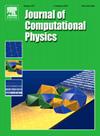Numerical methods and improvements for simulating quasi-static elastoplastic materials
IF 3.8
2区 物理与天体物理
Q2 COMPUTER SCIENCE, INTERDISCIPLINARY APPLICATIONS
引用次数: 0
Abstract
Hypo-elastoplasticity is a framework suitable for modeling the mechanics of many hard materials that have small elastic deformation and large plastic deformation. In laboratory tests for these materials the Cauchy stress is often in quasi-static equilibrium. Rycroft et al. discovered a mathematical correspondence between this physical system and the incompressible Navier–Stokes equations, and developed a projection method similar to Chorin's projection method (1968) for incompressible Newtonian fluids. Here, we improve the original projection method to simulate quasi-static hypo-elastoplasticity, by making three improvements. First, drawing inspiration from the second-order projection method for incompressible Newtonian fluids, we formulate a second-order in time numerical scheme for quasi-static hypo-elastoplasticity. Second, we implement a finite element method for solving the elliptic equations in the projection step, which provides both numerical benefits and flexibility. Third, we develop an adaptive global time-stepping scheme, which can compute accurate solutions in fewer timesteps. Our numerical tests use an example physical model of a bulk metallic glass based on the shear transformation zone theory, but the numerical methods can be applied to any elastoplastic material.
求助全文
约1分钟内获得全文
求助全文
来源期刊

Journal of Computational Physics
物理-计算机:跨学科应用
CiteScore
7.60
自引率
14.60%
发文量
763
审稿时长
5.8 months
期刊介绍:
Journal of Computational Physics thoroughly treats the computational aspects of physical problems, presenting techniques for the numerical solution of mathematical equations arising in all areas of physics. The journal seeks to emphasize methods that cross disciplinary boundaries.
The Journal of Computational Physics also publishes short notes of 4 pages or less (including figures, tables, and references but excluding title pages). Letters to the Editor commenting on articles already published in this Journal will also be considered. Neither notes nor letters should have an abstract.
 求助内容:
求助内容: 应助结果提醒方式:
应助结果提醒方式:


